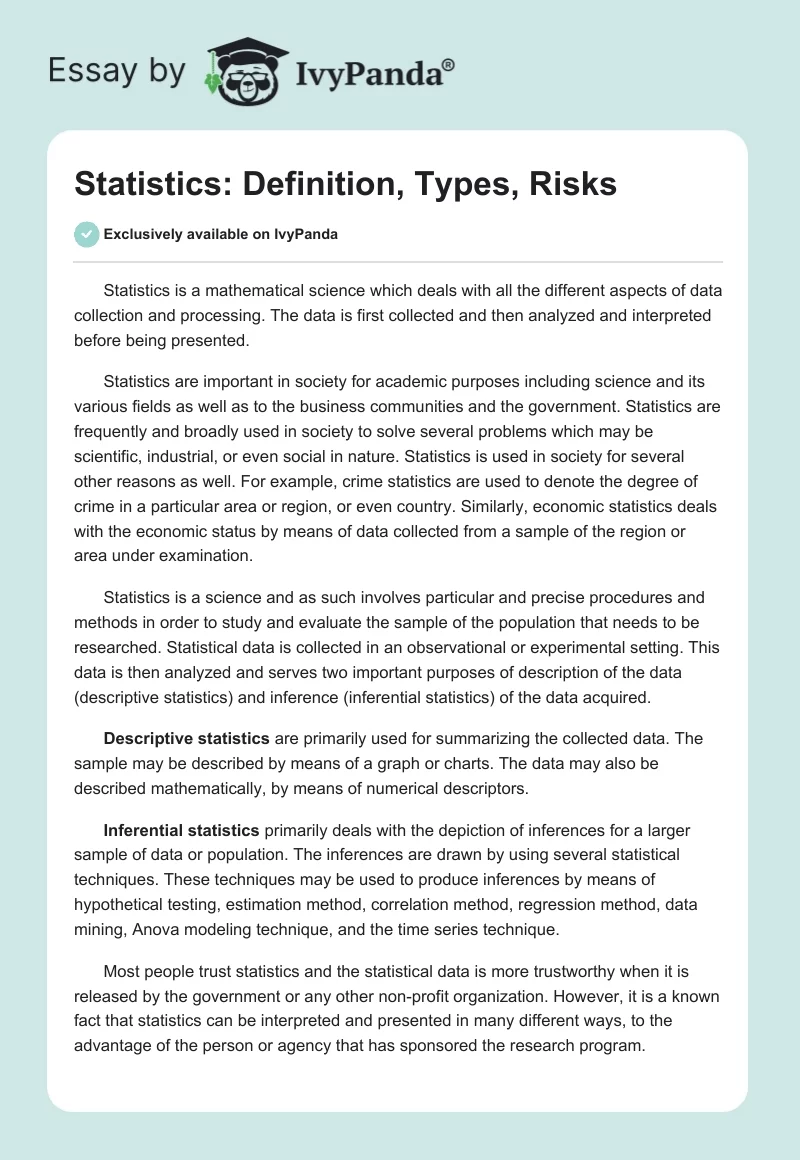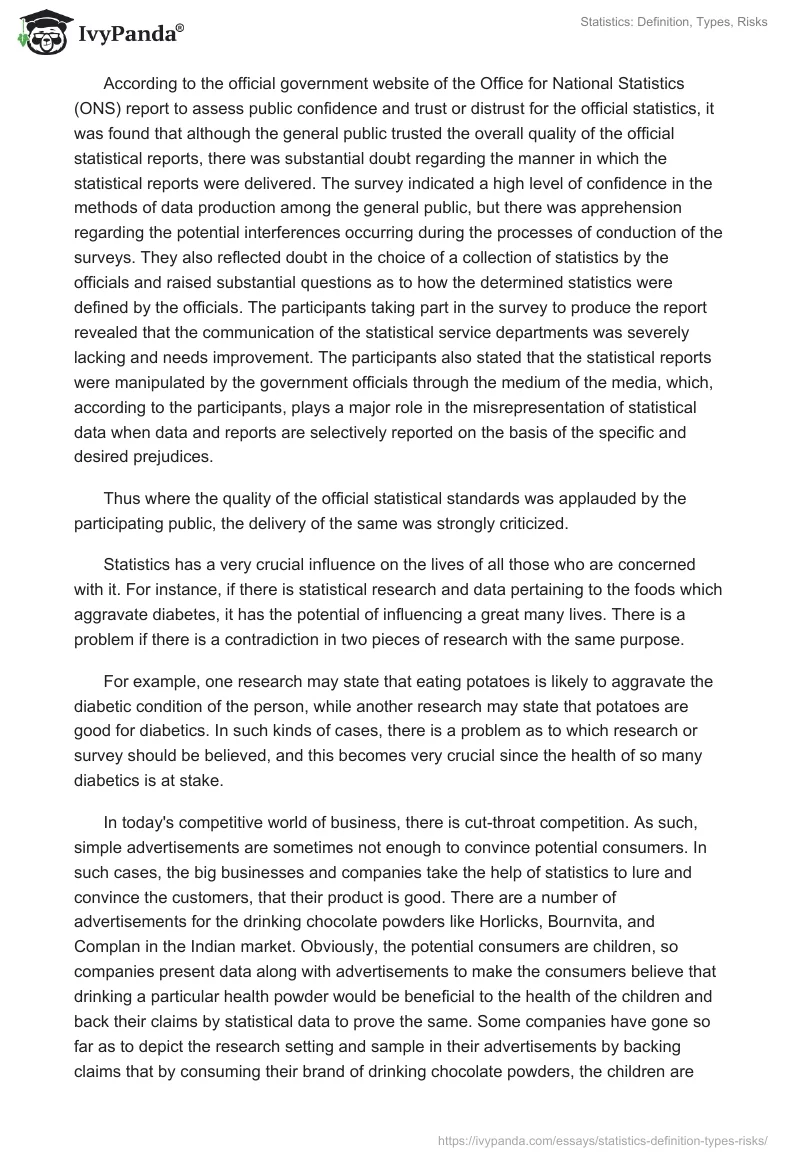Statistics is a mathematical science which deals with all the different aspects of data collection and processing. The data is first collected and then analyzed and interpreted before being presented.
Statistics are important in society for academic purposes including science and its various fields as well as to the business communities and the government. Statistics are frequently and broadly used in society to solve several problems which may be scientific, industrial, or even social in nature. Statistics is used in society for several other reasons as well. For example, crime statistics are used to denote the degree of crime in a particular area or region, or even country. Similarly, economic statistics deals with the economic status by means of data collected from a sample of the region or area under examination.
Statistics is a science and as such involves particular and precise procedures and methods in order to study and evaluate the sample of the population that needs to be researched. Statistical data is collected in an observational or experimental setting. This data is then analyzed and serves two important purposes of description of the data (descriptive statistics) and inference (inferential statistics) of the data acquired.
Descriptive statistics are primarily used for summarizing the collected data. The sample may be described by means of a graph or charts. The data may also be described mathematically, by means of numerical descriptors.
Inferential statistics primarily deals with the depiction of inferences for a larger sample of data or population. The inferences are drawn by using several statistical techniques. These techniques may be used to produce inferences by means of hypothetical testing, estimation method, correlation method, regression method, data mining, Anova modeling technique, and the time series technique.
Most people trust statistics and the statistical data is more trustworthy when it is released by the government or any other non-profit organization. However, it is a known fact that statistics can be interpreted and presented in many different ways, to the advantage of the person or agency that has sponsored the research program.
According to the official government website of the Office for National Statistics (ONS) report to assess public confidence and trust or distrust for the official statistics, it was found that although the general public trusted the overall quality of the official statistical reports, there was substantial doubt regarding the manner in which the statistical reports were delivered. The survey indicated a high level of confidence in the methods of data production among the general public, but there was apprehension regarding the potential interferences occurring during the processes of conduction of the surveys. They also reflected doubt in the choice of a collection of statistics by the officials and raised substantial questions as to how the determined statistics were defined by the officials. The participants taking part in the survey to produce the report revealed that the communication of the statistical service departments was severely lacking and needs improvement. The participants also stated that the statistical reports were manipulated by the government officials through the medium of the media, which, according to the participants, plays a major role in the misrepresentation of statistical data when data and reports are selectively reported on the basis of the specific and desired prejudices.
Thus where the quality of the official statistical standards was applauded by the participating public, the delivery of the same was strongly criticized.
Statistics has a very crucial influence on the lives of all those who are concerned with it. For instance, if there is statistical research and data pertaining to the foods which aggravate diabetes, it has the potential of influencing a great many lives. There is a problem if there is a contradiction in two pieces of research with the same purpose.
For example, one research may state that eating potatoes is likely to aggravate the diabetic condition of the person, while another research may state that potatoes are good for diabetics. In such kinds of cases, there is a problem as to which research or survey should be believed, and this becomes very crucial since the health of so many diabetics is at stake.
In today’s competitive world of business, there is cut-throat competition. As such, simple advertisements are sometimes not enough to convince potential consumers. In such cases, the big businesses and companies take the help of statistics to lure and convince the customers, that their product is good. There are a number of advertisements for the drinking chocolate powders like Horlicks, Bournvita, and Complan in the Indian market. Obviously, the potential consumers are children, so companies present data along with advertisements to make the consumers believe that drinking a particular health powder would be beneficial to the health of the children and back their claims by statistical data to prove the same. Some companies have gone so far as to depict the research setting and sample in their advertisements by backing claims that by consuming their brand of drinking chocolate powders, the children are likely to grow taller than the others who do not consume the same brand. This kind of promotion is absurd, for there is absolutely no information about the chosen sample, the circumstances in which the sample was tested, and whether the sample and the study are reliable or not. It is not only foolish but in many cases also highly dangerous to believe these company promotions when selecting the right kinds of foods for the children as, if the claims prove to be wrong, the health of the children could be in serious jeopardy. Sometimes, the average consumer is greatly affected by these misleading promotions and advertisements as also the children (in this case).
It is, therefore, true that statistics should be interpreted with caution as they can be misleading; it is also extremely correct that statistics can both lie and tell the truth. For, an intelligent person or persons can use the available data to interpret it to suit their purpose and advantage.
Since statistics is a science that involves interpretation as one of the crucial stages, there is a high likelihood that the collected data may be interpreted differently by two different persons. Further, the sample that is chosen may not be representative of the given population. Statistical data could have been simply acquired by means of interviewing or studying the basic facts of a few people’s lives.
There are also several dangers involved in the measurement of statistics. For example, in scientific experiments, there may be a sample of the population that will be exposed to certain chemicals or substances, to check the results. In such cases, the sample is at a potential health risk. Further, the size of the population may not be accurately represented in the given sample, so the results may not be equally representative of the entire population, likely to be affected by the results of the experiments. In such a case, when the sample is not representative, there is considerable danger to the target population, as the test may not have been accurately tested, or may not be applicable to the entire population.
References
Jaffe, A.J. and H.F. Spirer, 1987, Misused Statistics; Marcel Dekker, Inc., New York, NY.
Website of the Office National Statistics Survey. Web.


